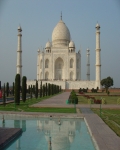Taj Mahal
Archaeology »
Archaeological Monuments » Taj Mahal
Taj Mahal - India
Taj Mahal is located in Agra,Uttar Pradesh.
Taj Mahal monument was established on 1653.
Primary threats to Taj Mahal :
Mughal Emperor Shah Jahan is in memory of his favorite wife, Mumtaz Mahal.
Historical facts of Taj Mahal :
- The Taj Mahal, one of the most iconic monuments in the world, is a masterpiece of Mughal architecture and a symbol of eternal love. Located in Agra, India, this magnificent white marble mausoleum was commissioned by the Mughal Emperor Shah Jahan in memory of his beloved wife, Mumtaz Mahal. Its historical significance, architectural grandeur, and timeless beauty make it a UNESCO World Heritage Site and a must-visit destination for millions of tourists from across the globe.
- Commissioning and Construction :
The construction of the Taj Mahal began in 1632 and took approximately 22 years to complete. The Mughal Emperor Shah Jahan, who ruled from 1628 to 1658, was grief-stricken by the death of his favorite wife, Mumtaz Mahal, during childbirth in 1631. As a tribute to her, he envisioned a grand mausoleum that would be unparalleled in its beauty and symbolism. The project employed thousands of skilled craftsmen, architects, and laborers from various parts of the Mughal Empire and beyond.
- Architectural Brilliance :
The Taj Mahal is an architectural marvel that seamlessly blends various design elements from Islamic, Persian, Indian, and Turkish styles. The primary material used for its construction is pristine white Makrana marble, which gives the monument its ethereal appearance. The main structure consists of a central domed tomb flanked by four elegant minarets at the corners.
- The mausoleum is set within a symmetrical and carefully planned complex, featuring lush gardens, reflecting pools, and ornamental fountains. The exquisite calligraphy, intricate inlay work of precious and semi-precious stones, and delicate marble screens known as jali, add to the splendor of the Taj Mahal.
- Symbol of Love and Romance :
The Taj Mahal is widely regarded as a symbol of undying love and devotion. The story goes that on her deathbed, Mumtaz Mahal made a heartfelt request to her husband, asking him to build a monument that would forever express the depth of their love. In fulfilling this promise, Shah Jahan immortalized their love story through the Taj Mahal, making it a monument of unparalleled romanticism.
- The Eternal Resting Place :
Within the grand mausoleum lie the tombs of Mumtaz Mahal and Shah Jahan. The graves are situated in a crypt below the main chamber, ensuring they remain forever enshrined within the breathtaking monument they inspired.
- Ingenious Architectural Symmetry :
The Taj Mahal's architectural brilliance lies in its precise symmetry. Every element of the monument is symmetrically aligned along its central axis, creating a mesmerizing sense of harmony. The reflection of the Taj Mahal in the surrounding pools further enhances this symmetrical beauty.
- Change of Perspectives :
The Taj Mahal appears to change color throughout the day, transforming from a soft pink hue at dawn to a pearly white during the day and a golden glow at sunset. This phenomenon is attributed to the interplay of sunlight on the pure white marble and the changing atmospheric conditions.
- Preservation Efforts :
Over the centuries, the Taj Mahal has faced numerous threats, including environmental pollution and natural wear and tear. In response, several conservation and preservation initiatives have been undertaken to protect this cultural gem for future generations. Efforts include strict emission controls to reduce air pollution in the vicinity and regular cleaning and restoration work on the marble surfaces.
- Conclusion :
The Taj Mahal stands as a testament to the enduring power of love and human ingenuity. Its historical significance, architectural brilliance, and captivating beauty make it an architectural wonder admired by people from all corners of the world. As a symbol of eternal love and devotion, the Taj Mahal continues to inspire awe and admiration, carrying forward its legacy through the annals of history.

